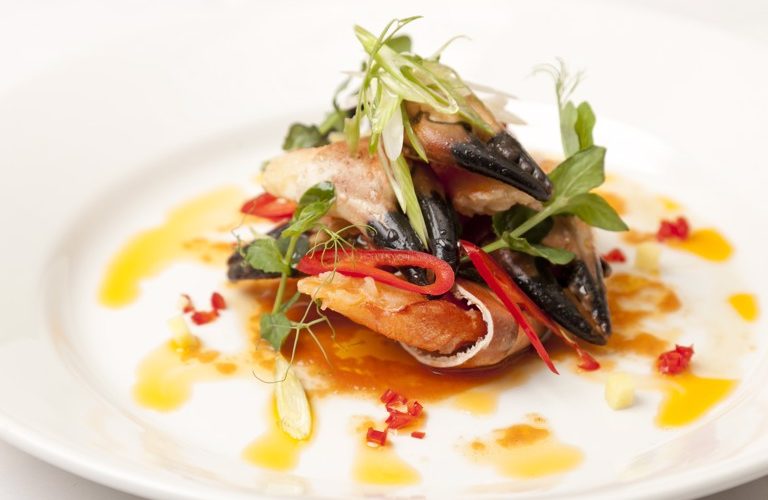Sometimes the messiest recipes will be the most satisfying to nibble on. Chunky crab claws are given a lick of smoke then tossed with an intense sauce, which will have you licking your fingers and asking for extra napkins. You can even cook the crab claws on a griddle pan, however the smoke of any barbecue infuses the meat with bags of flavour.
Visit: https://madisonsdish.com/
https://madisonsdish.blogspot.com/
Ingredients
METRIC IMPERIAL
6 crab claws
4 tbsp of chilli garlic sauce
1 tbsp of chilli oil, with sediment
2 tbsp of Shaoxing wine
1 tsp rice vinegar
3 spring onions, green part only, finely julienned
SAVE RECIPE
PRINT RECIPE
SHOPPING LIST
Method
Set up a barbecue for direct cooking
Cook the crab claws for about 4-5 minutes each side, depending on size
Set aside to cool a little, then crack lightly
Combine the rest of the ingredients (in addition to the spring onion) in a tiny bowl, then transfer to a saucepan and heat gently until it starts to bubble
Toss with the crab claws and serve garnished with the spring onion
1. CRAB IS A GREAT SOURCE OF PROTEIN
Crab is among the finest possible dietary sources of protein available. It contains almost as much protein per 100 grammes as meats without anywhere near to the same degrees of saturated fat, which is related to an increased risk of heart disease.
The protein in crab is of high quality and, due to a not enough connective tissue, very digestible for people of all ages.
2. CRAB CONTAINS LONG-CHAIN OMEGA-3 ESSENTIAL FATTY ACIDS
Rich in vitamins and minerals, crab meat is also lower in fat and contains Omega-3 polyunsaturated acids.
Helps provide protection from heart disease and aids brain development. Some research shows that Omega-3 also inhibits aggressive behaviour.
And it’s not merely any old Omega-3 – it’s the long chain variety. These tend to be more beneficial to our health because they can be used immediately, unlike short-chain Omega-3 found in vegetables and oils; they need to be converted to the long chain form first which our anatomies aren’t very proficient at.
100g of crab provides a third of the united kingdom recommended weekly intake of Omega-3.
3. CRAB CONTAINS SELENIUM
All shellfish are a good way to obtain Selenium but crab meat is specially abundant with it.
Selenium plays an integral role in the human’s antioxidant defence system, avoiding harm to cells and tissues.
Selenium also plays an important role in the function of the disease fighting capability, in thyroid hormone metabolism and synthesis in reproduction.
100g of crab meat provides 112% of the daily recommended value for men and 140% daily recommended value for women. Crab meat contains 3 times the amount of Selenium than cod and 12 times that of beef!
4. CRAB CONTAINS RIBOFLAVIN (VITAMIN B2)
As vitamins are water soluble, and therefore not stored in the body, they have to be obtained through our diet, such as through crab meat.
Riboflavin (Vitamin B2) is important in the production of steroids and red blood cells, the promotion of normal growth, and the maintenance of your skin, eyes and the nervous system.
Riboflavin also plays a role in iron absorption in the digestive tract and supports the game of antioxidants.
And take note all you athletes and bodybuilders: turnover of Riboflavin in the human body is thought to be related to energy expenditure, and thus physically active peoples may have an elevated dependence on Riboflavin in their diet.
